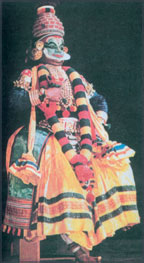The brilliance of Kathakali
|
|
|
The word Kathakali is derived from two separate words, i.e., "Katha" for story and "Kathaka" for story-teller. So, the story and its teller, have produced gems of brilliance that ancient citizens of India wrought the dance form of Kathakali.
Its birth was from within the corridors of holy citadels. One of the four main styles of Indian classical dancing, the rest being Kathak, Manipuri and Bharatha Natyam, is the embodiment of Indian theatre. This mime-oriented dance drama, came from the Malabar coast in South of India and gained perfection over 300 years ago.
Kathakali combines the rituals from ancient pre-Aryan origin in the form of dance, mime and drama. It has been registered in the Natyashastra that helped to materialise a perfectly integrated art of dance form including dance, drama, singing and instrumental music.
It was with a highly stylised vocabulary of gestures that finally Kathakali was born Masks and enhanced make-up play a great and important role with its various characters represented by faces of different colour and design.
Stories are from Indian mythology with gods playing supreme. The performance in the courtyard of a temple or holy place, continues from dusk to dawn. The story elements are of secondary importance because they emerged as a restoration of Hindu arts and a wee bit from Muslims.
|
|
Kathakali is watched and enjoyed by the audiences, seated on mats or slightly elevated platforms. Today, it is mounted on platforms and stages, yet draws huge crowds.
The best of Kathakali dancers emerge from the Kerala Kalamandalam Kathakali Dance Company and they have danced their history throughout the world.
The choreography dates back to the 16th century and movements based on a period of more than thousand years. Kathakali, the classical dance drama reincarnated the fabulous and ancient mythology of India. They dance the gods, divine sages as well as different demons in timeless tales of the good and the evil.
They also dance the three worlds - heaven, earth and hell. Many of the dances are performed in temple and retain a strong Eastern religious element. Today like yesterday, the performances in Kerala are mounted on specially constructed stages in the holy temples, are inaccessible to non-Hindus.
Elaborate make-up is used on Kathakali dancers which is considered more.
Completed with the brilliant bejewelled attire along with weird and towering head-dresses, dancers may look a strange sight for the first time audiences.
Exacting physical demands are needed for this form of dancing and as such, this art had been confined to men only for a long, long time and they danced women's roles too. But now it is different. Women add grace to Kathakali especially in the roles of Radha, Sita, Damayanthi etc.
Even William Shakespeare's plays were confined to men in the early centuries where young boys played Juliet, Portia, Cordelia, Ophelia etc. As in Kathakali, the times have changed and women do their roles better adding femininity where it is needed.
Rigorous training of years make Kathakali dancers perfect. The dancers have to be in perfect health, full of vigour and should have the strength of a bull.
There is also one important aspect in the training of Kathakali which are the eye exercises, done for full 15 minutes before their performances.
..................................





